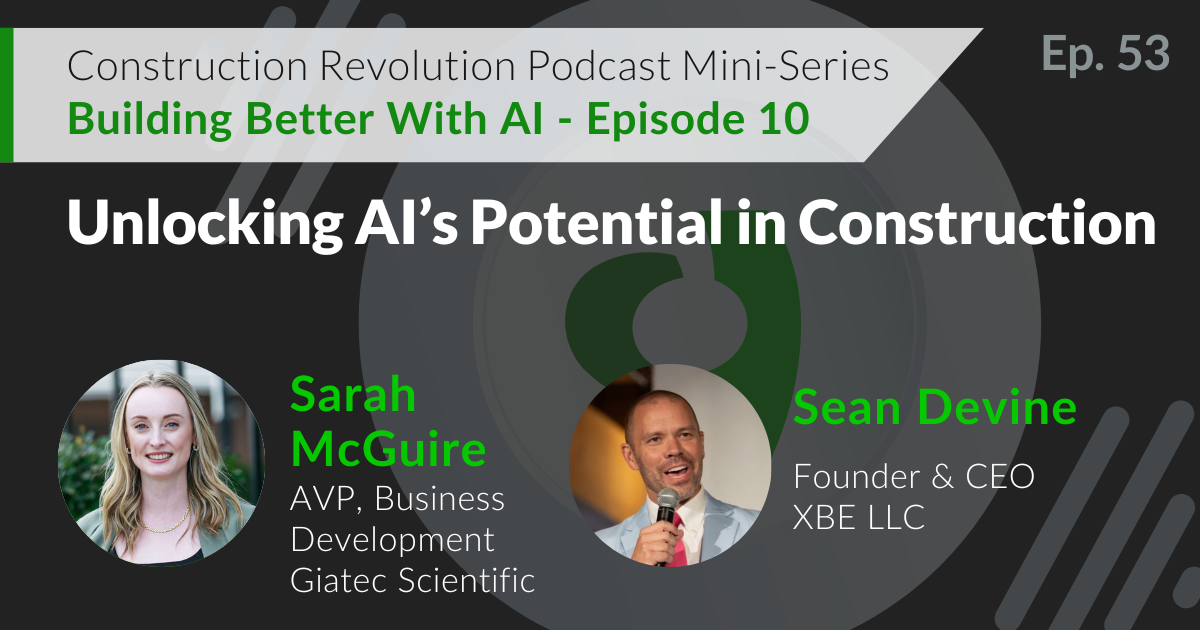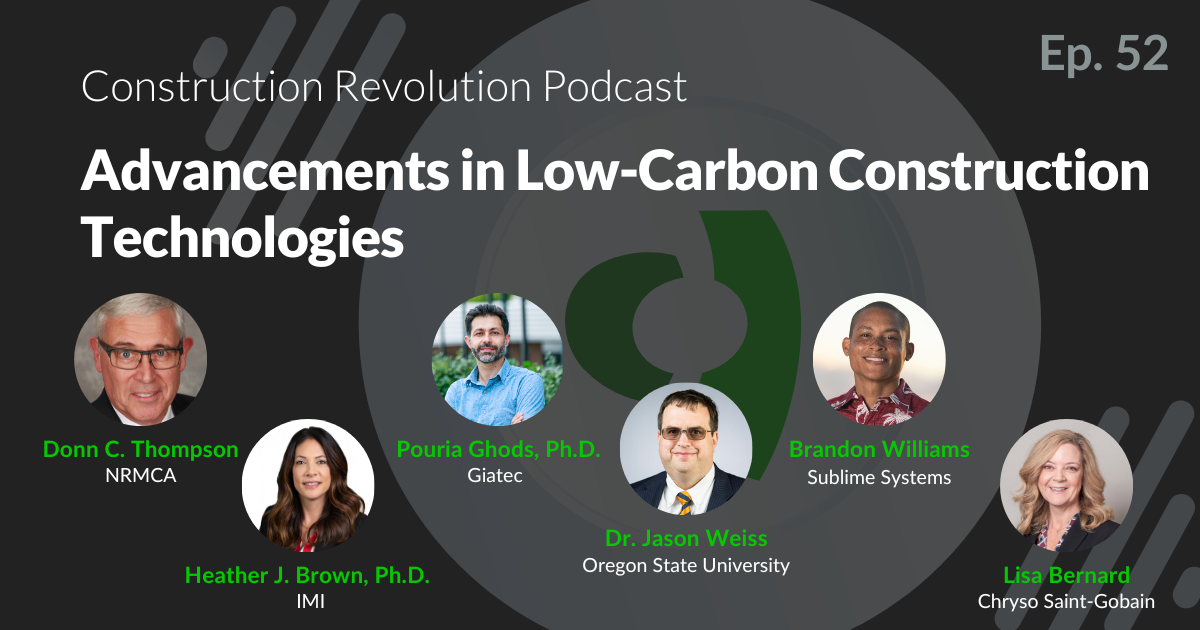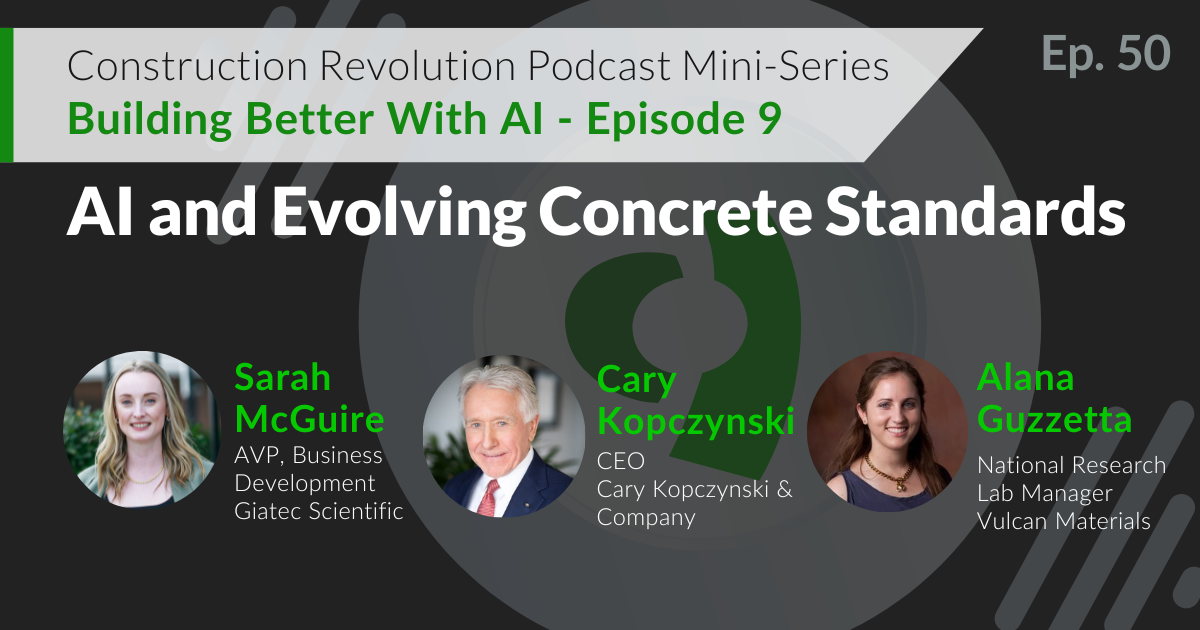
Episode 1 |
April 12, 2021
Bridging the Gap Between Science and Industry
In This Episode
On this episode the CEO and Co-Founder of Giatec Dr. Pouria Ghods shares his insights on creating and scaling up a start up in the construction industry and how the company uses its academic background to help bring new technology and practices to business around the world.
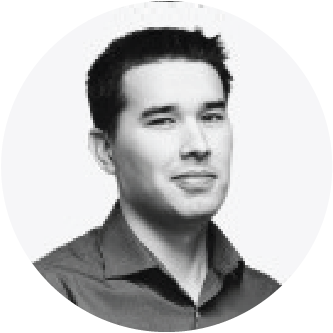
Host
ERIC YEE
Content Marketing Manager, Giatec Scientific Inc.
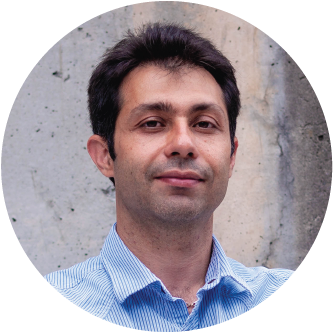
Guest
Dr. POURIA GHODS
Co-Founder and CEO Giatec Scientific Inc.
Podcast Transcript
Eric:
So I’d like to start off by going back 10 years prior to the start of Giatec. Could you walk me through what you were doing at the time and what caused you to start the company?
Pouria:
Yeah, thanks Eric. First, I would like to thank you for inviting me to this podcast series. So Giatec basically we established it 10 years ago. Going back 10 years ago, 2010, I just graduated from PhD from Carleton University and kind of at the same time, coincidence, my business partner, you know was doing the PhD. I kind of graduated a little bit earlier, six months earlier than me from Ottawa U.
And at that point, we were thinking that, what would be your… we had few options in terms of professional career. What would be our jobs basically in the long term of whether we’re going to go… We had a few options, as I mentioned. To be a prof at universities, research, further doing research or teaching, basically educating basically students. That’s on the other option we had going… joining another consulting company firm, especially in concrete materials, construction materials to basically doing engineering, more consulting work.
And the third option which happened to our paths, long-term paths that took us where we are at right now was try to do another… a new thing, out of the box, out of norm basically career paths, developing a company, like a establishment of the startup company to try basically with the product. Whether we can bring some of those high level, very advanced scientific knowledge that exists in academia, research, scientific paper, bring them to the application, to the construction site, to the concrete industry to solve the real-time problem. So more from practical point of view.
And whether we can basically bridge the gap between those two, basically, the market, like your education, very, very advanced stuff happening at universities. But in construction, unfortunately, you know the adoption of the technology is very low and as a result, there’s a huge gap between those two sectors. The level of knowledge is really high, but the adoption is very low.
We tried to bridge the gap basically through this company. And the key to that, how simple, or how far we can go with the simplicity to make a very advanced concept, scientific concept; to package it, very simple plug and play solution basically that construction industry can absorb it. And as a result, their adoption of that, the technology become faster over time and we get… We see in our lifetime at least, that was our vision, to see significant change to the extent of revolutionizing the industry in our lifetime. That was our vision. That was our passion basically. That’s what we were passionate about when we started this company.
Eric:
That’s fantastic. Thank you. And so it’s very interesting when you talk about there being such a large divide between where the science is at, the knowledge and academia and the adoption rate in the construction industry, the people that would be most impacted by it. So I can see a big challenge to bridge that. So during the early days of Giatec, what other challenges did you kind of face when entering the industry?
Pouria:
That’s a good question, Eric. One of the big challenges we had enter into industry, from our side, it was more a weakness of Giatec at that time was lack of understanding the industry as a whole, the whole system, construction industry as a whole, which is a big, big industry, over $10 trillion industry.
And we had just our view. Our lens was so narrowed basically to the industry. We were looking at the industry more from concrete science, corrosion science point of view. And as a result, we didn’t have a full understanding as we have in terms of the whole ecosystem and how we can basically bring a solution with much higher impacts that… Or to have the biggest impact possible at that time.
And that’s something basically came to us kind of as a evolution, so over the time, over the 10 years. So the level of understanding right now is much, much higher. And that was one of the biggest barrier to entry basically to the market that the solution we initially developed over the first few years until 2015 was more very advanced solution, very technical, addressing the big problem, but the market was very niche. Basically market we were trying to develop a solution, which is concrete testing labs initially like a very advanced device to look at the quality of the concrete, reliability of the concrete. It was really cool device. We still used this basically, sell that to the market. We have it as a part of offering, but the size of the market was quite, quite small.
And as a result, we couldn’t scale the business basically on that. Basically bring more offering and to truly impact the whole sector, not just the concrete sector, and also in concrete sector, a very niche part of that, which is a testing sector or a testing lab basically, testing setup.
And that was part of the mistake… And not the mistake, kind of learning curve we’ve gone through basically to understand a little bit better market first concrete in the city. Now, as of today, we have a good, much better actually at this understanding on the construction industry as a whole.
Eric:
That’s fantastic. I like how you started off saying it was mistake, but also it’s not because it’s just learning the right way to do things and where the opportunity truly lies as you learn things more and more.
Pouria:
Exactly.
Eric:
I know that Giatec is really known for the SmartRock, which is like a concrete sensor that measures temperature, can accurately predict concrete strength, but there’s a lot of other products that Giatec has. I’m wondering, maybe you could go into a few of them and how you saw a opportunity in the market and you kind of developed different solutions to address them.
Pouria:
That’s great. So, yeah, that was part of our evolution at Giatec. That’s a good basically follow-up question. Diving a little bit more what happened over the past 10 years, but, and also what was the journey that took us to the current point with the current offering compared to 10 years ago?
As I briefly mentioned, when we started the concrete testing device, it was really advanced. We were changing. At that time, we believed that we’re going to change significant concrete industry. But soon after we found that, again, the market size is not big enough and we had a pivot basically 2013, yeah, around 2012, ’13, get into the more consulting solution, engineering solution for non-disruptive assessment or conditional assess of current infrastructure, existing infrastructure.
And we came up with two devices currently named, iCOR and XCell for the corrosion assessment of infrastructures. And with that two product, we had a little bit further traction. Market was bigger. The pain was much bigger. And as a result we had to have further traction to the market. But the problem we had, our business model was not a really basically attractive business model. So we established a corporation, so to scale the corporation. The business model was high price tag with the high margin product, but something that would last 20 years in the hands of the customers. And there’s not much repeat revenue and there is not much growth basically to scale the company.
And in 2015 we found that, okay, so we need to make another pivot at that time to fix the business model, the revenue model mainly. How we can basically have… approach a much bigger market again, right revenue model and basically the right strategy. And 2015, we came up with the concrete sensor line, and that concrete sensor was a disposable sensor where it can be used just once basically for every pour. And as a result the market was much, much bigger. So every concrete pour that happening on the planet, they need a few sensors for monitoring the concrete sensor in the field. There’s more in-situ monitoring of concrete. But high volume, low price tag, but still high margin basically business.
And with that, basically, we see that business is scaling quite rapidly, 50% year-over-year growth. And as a result, we basically start making the corporation bigger by more hiring, increasing the staff and start focusing on that line of product by bringing second generation of the sensor 2017 and the third generation a few months ago, 2020.
And we still have plan basically to bring more, and the next generation of the sensor by increasing the… Basically broadening the features and capability of the sensor that is still disposable, can be… It would be used basically as a IoT solution to provide more information on the quality or characteristic of the concrete during… after pouring at different stages. And we are planning to expand the application of the sensor even before the pouring time when concrete is in the production batch in plant, all the way to a transition.
As well as the other side of that after pouring all the way through the life of the infrastructure to basically have a kind of end-to-end solution, and from beginning to end kind of visibility to the concrete quality. That’s our kind of vision right now, high vision approach to the concrete industry.
Eric:
It’s really interesting hearing the story of how you kind of pivoted products. One thing that I, just on a personal note, I wanted to ask you was how does it feel or when you think back to where you started, knowing where you are now, it must be a very cool or very exciting feeling to create a product and then have a company grow around it.
So Giatec had its 10th birthday earlier this year, which is a huge accomplishment. With that amount of time in the industry, what have you seen change?
Pouria:
Compared to last 10 years ago?
Eric:
Yes, 10 years ago.
Pouria:
That’s good because now I understand very well your question. There have been many changes actually happening over the past 10 years. One is basically internal. So maybe I can classify them to internal change and what is happening at Giatec and external changes, what is happening to the market.
As a whole… Maybe I’ll start with the external one. What we are seeing, we have been seeing basically that happening in the markets is digitalization and basically the change in the construction industry as a whole, adopting more technology, basically becoming more technology company than construction, like a builder company. So there is a big trend and movement there that we are seeing, especially these days that most of the construction companies are more open and basically moving, even rallying in some case behind the technology, promoting the technology. That was not the case in 2010. So then we started the company.
Now there is more level of adoption and openness basically for technology, embracing the technology, new things, much, much higher level of desire in the market compared to 10 years. This is a good news. This is a good news not only for us, for the construction industry as a whole, and we will probably be diving… We’ll see over the next five to 10 years significant changes, or maybe to the extent of revolutionization of the industry as a whole over the five, 10 years.
And that has come with all threats and also opportunities. Depends on where you are at in this spectrum. If you’re early adopter, that would be great opportunity. But if you are late adopter or old kind of mindset, customer kind of in the market, so that might be threat because if you’re too far behind the crowd, you may miss basically opportunity or it might be too late basically for adoption of the technology.
That’s something we have seen over the 10 years on the market side, but internally at Giatec, what we have seen that kind of evolutionary, not revolutionary. No, there’s still… We have the same level of passion, same level of desire, creativity, culture, like a culture. Our Giatec culture is around three things, are around creativity, passion, as well as integrity.
From that perspective, not much seems… not much changes we have right now compared to 10 years ago. It’s pretty much the same thing. Still very passionate every day coming into the office. Still, we want to be creative, to bring the… to use innovation, to be innovative as much as we can as well as more integrity, which is a must thing to have. We would like to treat everybody with respect, high level of integrity, transparency, all those things that come with integrity.
But one thing that you changed when compared to 10 years ago, the level of maturity we have in the team, the corporate maturity significantly increases year over year. With more resources, more senior people, experienced people and also ourselves, myself even, understanding better the market and also gaining experience from a business side, how to run the business, how to manage business as a CEO.
Basically these are the changes I see that we didn’t have those kind of capability, resources, or mentality when compared to 10 years ago. We think much, much bigger compared to 10 years ago as an organization. And also we set ourselves with much, much bigger success right now compared to 10 years ago. This is more basically to grow a part of the maturity that we’re getting, the corporate maturity that we are gaining and that’s for every five years, we set a bigger goal for the company. 2015 we set a goal to be dominant in concrete sensor.
Now we are seeing that we are the market leader, and next five years, we have another goal, basically to be much bigger and also as a result impact. That’s what we are more passionate about. Just have a higher impact, bigger changes, make a planet better places for living. So by making a quality of the concrete infrastructure better, and also the footprint of construction, carbon footprint of construction, GHG basically emission on the planet less. Like [inaudible 00:15:29] we can later on in another session with me or our CTO basically, Aali Alizadeh, get into that, the detail of what we’re trying to establish from a technology point of view.
But yeah, definitely every five years, we set higher goal compared to 10 years. We have much higher, bigger challenges, but at the same time, very excited to say no because as we grow, we basically raise the bar higher, higher so that when we wake up, we have something to do. Otherwise, there’s no job for me. That’s how I see my job. Not only set the bar higher, but also work with the team, basically to rally the whole team to basically move faster and basically achieve a much higher goal that as a human being be able to have some greater, bigger impact in our lifetime if it’s possible.
Eric:
I think that’s something that a lot of people strive for is to have some kind of lasting impact on the world after they kind of leave it. So as one of the leaders in the industry, looking forward now, what trends do you see, or what can you maybe predict that you think will happen or would like to see happen over the next 10 years?
Pouria:
That’s a very good question. Next 10 years is of course is difficult to predict. There’s lots of unknown uncertainties there, but the way we see from the past and kind of extrapolating basically the trend basically from the past, for the future, moving forward kind of extrapolation is telling us that the era of Internet connectivity, basically, the connectivity that we are getting in a way that in a second, a portion of the second you get access to information on the other side of the planet. So the [inaudible 00:17:29] of the globe with a portion of this. Any data that you can imagine, you can have access at your fingerprint.
So this is possible, became possible over the past 20 years because of the connectivity, Internet, connectivity, telecommunication advancements. There are lots of advanced, Internet by itself. And my view on that is probably that connectivity basically would change the construction industry dramatically or in a positive way. So in a positive way that everything going to be connected in construction industry, in concrete industry. Everything would be measurable, everything basically would be quantifiable.
And as a result, there are lots of efficiencies or productivity and basically derisking of the whole business construction, highway construction business, from safety point of view, from financial would be happening in a positive way again because of the connectivity. So that we are seeing that impacting every signal of light, like a smart city, connected car, vehicle, or everything that you see in other sectors would be seen basically or would be adopted in the construction industry in the same fashion.
Might be a little… but the rate is a little bit core question but it’s happening or not, my hunch is that yeah, definitely it’s going to happen. But what would be the rate of adoption, what would be the rate, I guess that would be more questionable, whether it’s going to be significant rate of the change or trend in the construction or not. I guess that’s the bigger question, but there are a couple of signs telling us that that’s going to be relatively fast comparable to other industry sector like a whole sector or compared to transportation sectors, food, agriculture industry. It seems that construction is picking up in terms of the technology trends.
Eric:
I know that the construction industry was typically maybe a slow adopter, but it does seem like from my limited exposure, they are ramping up quite quickly compared to other industries.
Pouria:
Exactly. Yeah, yeah, exactly.
Eric:
Well Pouria, thank you so much for taking the time out of your busy schedule to talk with me today. I really appreciate it and I’m sure our listeners will as well.
Pouria:
Yeah, thank you very much, Eric, for inviting me and having me. That was a really great conversation and really enjoy basically exchanging idea with you. Thank you very much. Have a good day.
Eric:
Thank you so much. Bye.
Pouria:
Bye.
Other Related Episodes
Episode 53 |
December 12, 2024
Unlocking AI’s Potential in Construction
In this latest episode, host Sarah McGuire sits down with Sean Devine, Founder and CEO, XBE, to explore the transformative role of AI in the construction industry. With a background in logistics and technology, Sean brings unique insights into the challenges and opportunities surrounding AI adoption in construction. Sean highlights untapped opportunities and discusses how XBE is leading the charge with innovative solutions, including AskConcrete— a groundbreaking answer engine powered by decades of NRMCA data, designed to tackle complex questions about ready-mixed concrete. From identifying industry limitations to exploring what companies need to do to embrace AI effectively, Sean offers a compelling roadmap for innovation. He also shares his journey in founding XBE and his mission to optimize heavy construction operations with cutting-edge technology. Tune in to gain valuable insights into how AI is shaping the future of construction. Don’t miss this enlightening discussion!
PLAY
Episode 52 |
November 14, 2024
Advancements in Low-Carbon Construction Technologies
Join us for an engaging and insightful panel discussion from 2024 Net Zero Construction Conference, hosted by Aali Alizadeh, Ph.D., Co-Founder and CTO of Giatec and Technology Chair of The Net Zero Construction Conference. This episode dives into groundbreaking advancements in low-carbon construction technologies, highlighting both the promising opportunities and the significant challenges involved in their industry adoption.
Our distinguished panel of experts features: Professor Jason Weiss from Oregon State University, Heather Brown, Ph.D., Vice President of Quality Control/Quality Assurance at Irving Materials Inc. (IMI), Donn Thompson, Senior Director of Building Innovations at the National Ready Mixed Concrete Association (NRMCA), Brandon Williams, Business Development Manager at Sublime Systems, Lisa Barnard, Sustainability & EPD Program Manager at Chryso Saint-Gobain, and Pouria Ghods, Ph.D., Co-Founder and CEO of Giatec. Together, they offer a wealth of knowledge on the latest advancements in sustainable construction, sharing how innovative materials and solutions are transforming the industry.
Don’t miss this opportunity to learn from industry leaders as they share actionable insights and strategies that can drive meaningful change in the construction landscape.
Want to dive deeper into conversations like the ones in this episode? Join us at the Net Zero Construction Conference 2025 on March 19-20 in the Virbela Metaverse! Experience two days of expert panels, innovative insights, and networking opportunities focused on low-carbon construction technologies. Learn more and get your tickets on the N0CC website!
PLAY
Episode 50 |
October 3, 2024
AI and Evolving Concrete Standards
Our “Building Better with AI” mini-series is back by popular demand! Originally planned as an eight-episode series, the overwhelming response from our listeners has brought us back for more. Please join us for our ninth episode, “AI and Evolving Concrete Standards”! In this episode, we’re unpacking the challenges of concrete constructability, why industry stakeholders must improve communication, and how AI can help bridge this gap. Joining us are Cary Kopczynski, CEO, Cary Kopczynski & Company, and Alana Guzzetta, National Research Lab Manager, Vulcan Materials. Together, they explore the impact of evolving ACI standards on concrete performance, constructability, and sustainability, along with the major opportunities and challenges that AI presents as the industry advances. Filled with insights and a call to action for the entire industry, this episode is a must-listen for professionals eager to stay ahead in the concrete world. Tune in for a conversation that’s not just about keeping up with change but leading it!
Full McKinsey Report:
REINVENTING CONSTRUCTION: A ROUTE TO HIGHER PRODUCTIVITYPLAY
Want to Be a Guest Speaker, Sponsor, or Just Have a Question for Us? Fill In the Form!

